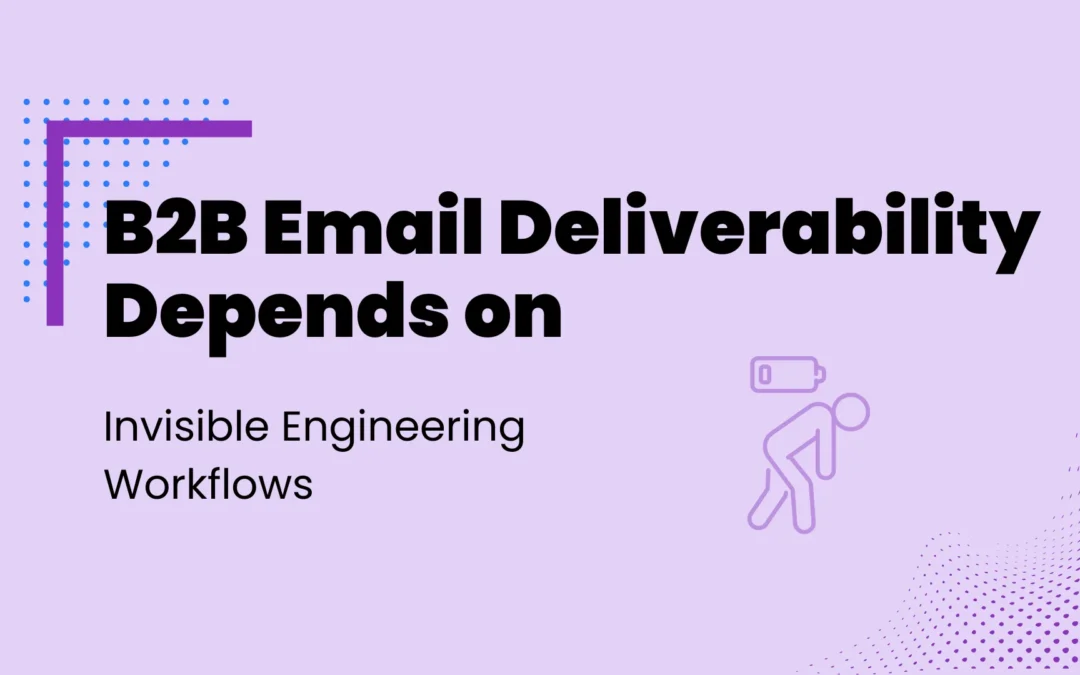B2B email deliverability relies on hidden technical processes. Invisible engineering workflows like SPF, DKIM, and strict DNS hygiene ensure your cold emails land in recipients’ inboxes instead of spam folders.
SPF, DKIM, and DNS: The Foundation of Deliverability
For effective B2B lead generation via cold email, you first need proper email authentication and clean DNS records. Protocols like SPF and DKIM tell recipient servers that your messages are legitimate and actually from your company. Many corporate mail systems (like those using Google or Microsoft) will flat-out reject emails that fail these checks. Misconfiguring or skipping them means even great content may never reach a prospect’s inbox, damaging your email deliverability. Adding a DMARC policy on top further ties these measures together to prevent anyone from spoofing your domain. In short, a properly authenticated domain appears trustworthy to other business email systems, greatly improving your chances of reaching the inbox.
• Set up an SPF record in DNS to authorize your sending mail servers. This ensures only authorized servers can send on your behalf.
• Use DKIM to attach a unique cryptographic signature to each outgoing email. This proof shows the email was truly sent from your domain and hasn’t been altered.
• Enable a DMARC policy to enforce SPF and DKIM alignment and protect your domain from spoofing. It tells recipient servers how to handle emails that fail authentication.
Domain Reputation and Warm-Up: Earning Sender Trust
Why do emails from a brand-new address often end up in spam, even if the content is good? It’s because the sender has no established reputation yet. B2B companies often use dedicated domains for cold outreach to avoid risking their main brand domain. Starting with low send volumes and ramping up gradually builds a positive sender reputation over time. This email warm up period lets mailbox providers observe consistent, low-volume activity before you scale up fully. It signals to spam filters that your domain is trustworthy.
For example, you might start with just a dozen emails per day and gradually increase over several weeks. Some teams even use automated warm-up tools that send and reply to emails in the background to build a positive sending history. Such warming practices prevent your sales emails from looking like sudden spam blasts. Many teams spend a few weeks on a warm-up phase for any new domain or address. It’s like building credit: consistent, responsible sending builds trust, whereas sudden spikes or spammy behavior can wreck your reputation.
• Warm up new email addresses by sending a small number of emails at first, then slowly increasing, to build trust gradually.
• Avoid blasting thousands of cold emails from a brand-new domain or IP address without history, since a sudden flood from a new source looks suspicious to providers.
• Consider using a separate domain or subdomain for outreach to protect your main business domain’s reputation and segregate any deliverability issues from your primary email traffic. This way, deliverability problems on the secondary domain won’t impact your primary domain.
Quality Content and Sender Behavior: Staying Out of Spam
Think your job is done after setting up SPF and DKIM? Not quite – poor emailing practices can still trigger spam filters. Keep your cold email content professional, personalized, and relevant to each prospect.
Avoid gimmicky marketing language or excessive punctuation that might look like spam.
Highly generic, template-like emails are easy for recipients (and filters) to spot and ignore. Instead, personalize your outreach where possible and tailor the message to the prospect’s needs to keep engagement high. Always include a clear unsubscribe option to give recipients an easy opt-out, and be mindful of how often you message people. Also, send only to contacts who might truly benefit from your offer. Continuously remove addresses that bounce or never engage to keep your sending list clean. Remember, if too many recipients ignore or delete your emails, future messages might land in the junk folder.
• Avoid spammy words, misleading subject lines, or all-caps formatting in your email copy; these are red flags for spam filters.
• Include a clear unsubscribe link to comply with regulations and show respect to recipients’ preferences. This keeps you transparent and trustworthy.
• Remove hard bounces and unresponsive contacts from your list regularly to maintain a healthy sender reputation. Don’t keep emailing people who never respond.
Intent Data and Smart Targeting: Quality Over Quantity
Even with perfect infrastructure, blasting cold emails to random lists will hurt deliverability and waste effort. Successful B2B lead generation campaigns focus on quality prospects who fit an ideal customer profile. It’s often better to email 100 interested, relevant contacts than 10,000 people who have no need for your solution.
Using intent data – signals like recent site visits or content downloads that indicate a prospect’s interest – helps you identify leads likely to engage. Sources of intent data might include tracking visitors to key pages on your website, monitoring relevant keywords prospects search for, or using third-party intent data providers. By focusing your outreach this way, you also avoid bothering people who have no interest, protecting your brand’s reputation in the process. Many B2B companies now integrate intent data into their sales tools or CRM systems, automatically flagging high-interest leads for outreach. Fewer, targeted emails mean better deliverability and more meaningful replies. This also means your domain and IP avoid the bounces or spam complaints that come from emailing uninterested recipients.
• Use intent data to find prospects showing buying interest. For example, see which companies are researching topics related to your product or visiting your site often.
• Prioritize quality leads over sheer volume; a smaller engaged list is far more valuable than a huge cold one that might mark your messages as spam.
• High open and reply rates from interested recipients boost your sender reputation and email deliverability over time. In contrast, low engagement or spam complaints can hurt it.
AI-Powered Agents: Behind-the-Scenes Deliverability Management
Who has time to monitor all these technical details around the clock just to maintain email deliverability? Sales development teams need to focus on B2B lead generation, not get bogged down managing DNS records.
Thankfully, modern sales tools and AI for sales can now automate most deliverability tasks.
These advanced systems act like an infrastructure agent working quietly in the background. They configure your DNS records correctly, handle ongoing email warmup, and automatically adjust send timing or volume based on real-time feedback. Some even analyze each prospect’s email server (for example, Gmail vs. a corporate Exchange) and choose the best sending approach for that environment. For larger campaigns, the system might spread out messages across multiple sender accounts or domains to avoid overloading any single mailbox. They can also monitor blacklists and feedback loops continuously, catching any reputation issues early. This invisible automation gives you high deliverability without manual effort, letting your team focus on selling instead of firefighting technical issues. Even small teams can now leverage such technology, gaining deliverability capabilities once reserved for large companies with dedicated IT staff.
• Modern AI-driven sales tools can automatically handle SPF, DKIM, and other email setup steps for you. That means you don’t have to edit DNS settings by hand.
• An intelligent infrastructure agent monitors your sending. It adjusts timing or rotates sender accounts to keep email deliverability high, reacting to any issues instantly.
• By using advanced sales tools, teams ensure technical factors are optimized without needing specialized IT knowledge or tedious manual work. This frees your team to focus on connecting with prospects instead of troubleshooting technical steps.
Conclusion
In B2B outreach, success isn’t just about great messaging – it’s about the invisible engineering behind the scenes. By mastering authentication, reputation management, content discipline, and smart targeting, you ensure your cold emails reach and resonate with prospects. High email deliverability means more opportunities and a healthier pipeline for B2B lead generation. Earning and maintaining inbox placement has become a competitive advantage in modern B2B sales outreach. Teams that invest in these behind-the-scenes factors see far better results from their cold email efforts.
GetReplies – The Invisible Workflow Solution
GetReplies is an AI-driven SDR platform that automates these invisible workflows. It acts as an infrastructure agent for your outbound campaigns. The system manages your email authentication, domain warmup, and sending cadence behind the scenes. It also uses intent data and multi-channel outreach, so B2B teams can book more meetings with less effort. As a result, your cold outreach consistently turns into real opportunities.

